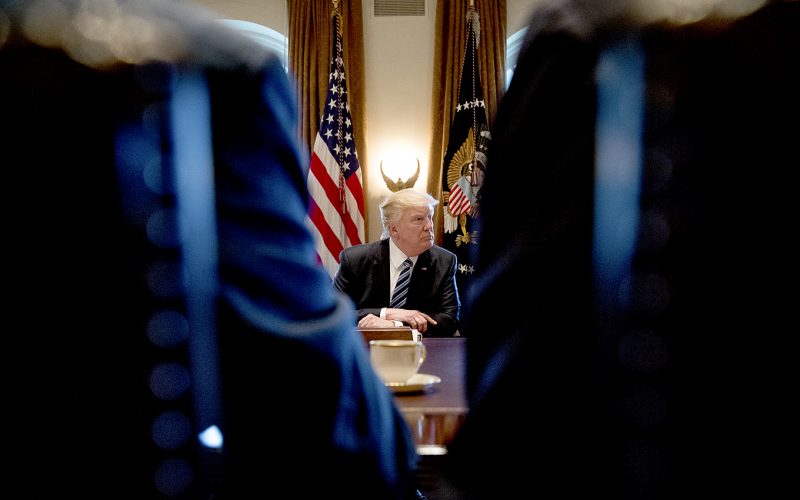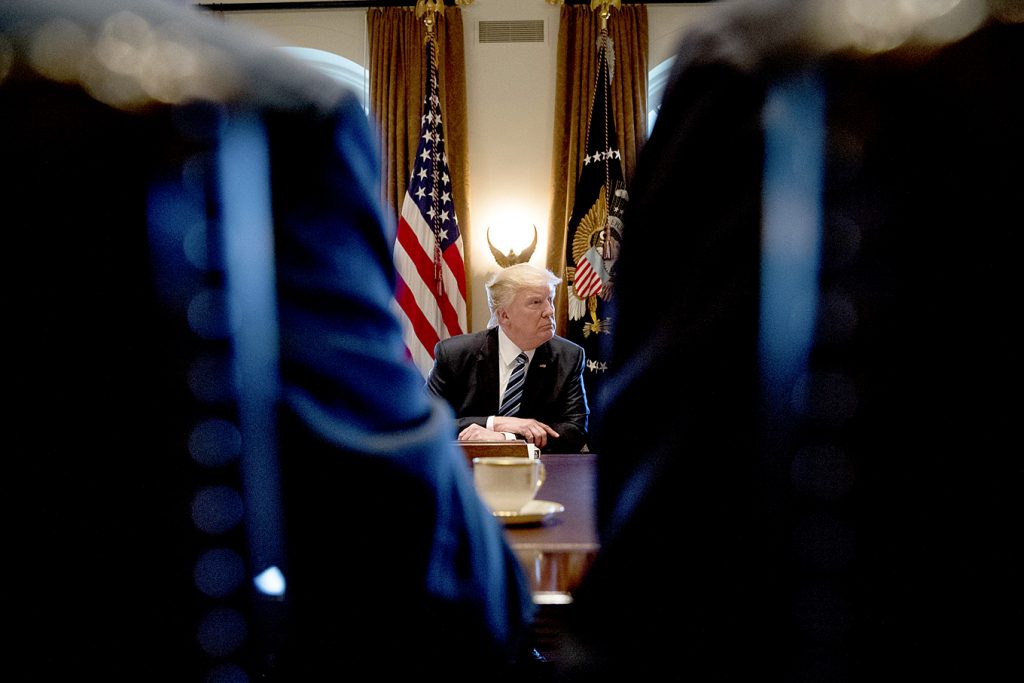- President Donald Trump meets with his Cabinet in the Cabinet Room of the White House in Washington, Monday, March 13, 2017. (AP Photo/Andrew Harnik)
People in the media are having difficulty in figuring out where Donald Trump’s administration stands on foreign policy issues. He’s a shape-shifter, and in just the last week he has completely changed his stance on Russia, China, NATO, and Syria—all without blinking, without apology, and without explanation. Frankly, I doubt that he pays attention to these changing views; to him they simply show his “flexibility.”
In the real world of international politics, such shifts can’t be dismissed as unremarkable. We’re talking, after all, about serious adversaries—Russia, China, and North Korea—each of which, if not dealt with carefully and with full understanding of the issues in contention, could take steps that lead to war, even nuclear war. The fundamental problem is that the conduct of foreign policy under Donald Trump is amateurish and dangerous, creating the possibility of a catastrophic miscalculation.
Consider: the administration must deal with a Russian leader who has ambitions to restore his country’s status as a great power; with a Chinese leader who wants his country to be co-equal with the United States in world affairs; and with a North Korean leader who wants his country to be acknowledged as a nuclear-weapon state and accorded legitimacy and security assurances. The lesson? They all need to be treated with respect and great delicacy, mindful that each has substantial military capability within easy reach of important US allies, not to mention the US itself.
A Cardinal Rule
So how has the Trump administration dealt with these adversaries? He has adopted all the standard actions typical of US-style crisis management: reprisals, sanctions, warnings, force deployments, threats. These actions violate a cardinal rule of diplomacy: Threats will most likely produce a reaction exactly opposite of the one desired. Threats incite nationalist fervor, invite counter-threats, and obstruct dialogue. Nevertheless, Trump has chosen to violate that rule, with the following results:

FILE – In this Saturday, Feb. 11, 2017, file photo, U.S. President Donald Trump, right, listens to Japanese Prime Minister Shinzo Abe as they make statements about North Korea at Mar-a-Lago in Palm Beach, Fla. North Korea often marks significant dates by displaying military capability, and South Korean officials say there’s a chance the country will conduct its sixth nuclear test or its maiden test launch of an ICBM around the founding anniversary of its military on Tuesday, April 25. Trump spoke by phone with both the Japanese and Chinese leaders Monday, April 24. Abe and Trump agreed to urge North Korea to refrain from what Abe called provocative actions.
(AP Photo/Susan Walsh, File)
With Russia the US has issued what amounts to an ultimatum: distance itself from Syria, or at least do not condone Syria’s use of chemical weapons. The Russians, of course, reject an ultimatum and reject the accusation that Syria used chemical weapons. They threaten to retaliate if the US attacks Syria again.
With China the US demands a change in the terms of trade and Chinese pressure on North Korea to reduce or eliminate its nuclear weapons. Otherwise, says Trump, the US will act on its own against the North. China promises nothing other than a joint review of the trade picture. Xi Jinping didn’t even bring a trade expert with him to the meeting with Trump. As for pressuring Pyongyang, one semi-official Chinese newspaper has mentioned the idea of cutting off North Korea’s fuel supply from China, something China has done before for a short period. On the other (and more convincing) hand, China’s trade with North Korea is up 37 percent this quarter compared with a year ago. Trump sweetens the pot by withdrawing his longstanding charge that China is a currency manipulator, hoping China will salvage the uncompromising US posture. In his usual childlike way, Trump thinks that Xi’s love of the chocolate cake served at one of their dinners means Xi goes along with Trump’s gunboat diplomacy.
With North Korea Trump deploys an aircraft carrier strike force off the Korean coast, presumably to warn Pyongyang that some further provocative step might meet with a forceful US response. Dropping a “mother-of-all-bombs” in Afghanistan is widely believed to send the North Koreans a further warning of US capabilities. But North Korea threatens nuclear war if attacked, says it can easily destroy US bases in South Korea, warns that it is not another Iraq, Libya, or Syria, and carries out yet another missile test (which fails) and huge parade of its missile inventory. A sixth nuclear-weapon test may yet come.
Trump claims that his missile strike on a Syrian military airport was a great success, that his meeting with Xi went beautifully, and that North Korea and Russia are in great trouble. The reality, of course, is quite different: Trump’s actions have raised the stakes with all three countries without having resolved major issues such as Russia’s meddling in the US elections, defeating ISIS in Syria, reducing tensions with China over the South China Sea or THAAD, or ending the nuclear weapons and ballistic missile buildup by North Korea.
Alternatives
If the US objective with Russia, China, and North Korea were to avoid war by accident or design and instead create a path to potential conflict resolution, here are some thoughts about what Trump might have done and can still do.

South Korean protesters stage a rally against U.S. deployment of the USS Carl Vinson aircraft carrier and its battle group to the Korean Peninsula, in front of the Defense Ministry in Seoul, South Korea, Tuesday, April 25, 2017. North Korea marks the founding anniversary of its military on Tuesday, and South Korea and its allies are bracing for the possibility that it could conduct another nuclear test or launch an intercontinental ballistic missile for the first time. The signs read “Stop military action on the Korean Peninsula”. (AP Photo/Ahn Young-joon)
With Russia, why not accept Putin’s proposal (supported by Bashar al-Assad) for an international investigation of the chemical warfare claim? If Washington is so convinced of Syria’s responsibility—and if Trump believes Russia might well have known about the attack in advance—the US should welcome an investigation with confidence in the outcome. As for the immediate future, the Trump administration should establish Putin’s strategic interest in protecting Assad and seek ways to substitute for it. Trump might, for example, promise no further missile strikes in exchange for Russia’s assurance that Assad will never again employ chemical warfare and will destroy the chemical stocks he has hidden under international inspection. In exchange for ruling out regime change in Syria and removing some sanctions on Russia, Russia would assure the US that it will respect safe zones for anti-Assad forces and people.
With China, Trump has already dropped his incorrect accusation that China is a currency manipulator. Now he must also drop his linkage of trade relations with Chinese pressure on North Korea. Last week Trump tweeted: “I explained to the President of China that a trade deal with the U.S. will be far better for them if they solve the North Korean problem!” But now he may have come to the realization that, as with health care, “it’s complicated.” In an interview with the Wall Street Journal, Trump said: “After listening [to Xi Jinping] for 10 minutes, I realized it’s not so easy. I felt pretty strongly that they had a tremendous power [over] North Korea. … But it’s not what you would think.” No, it isn’t.
Hopefully, Trump will stop trying to bait Xi on trade, reevaluate North Korea policy (see below), and focus on larger issues in US-China relations. Trump now says, once again in direct contrast with previous scorching criticisms of China, that he and Xi “get along really well, I really like being with him.” If so, the administration might take up China’s plea not to rely on sanctions and to resume negotiations, which its foreign minister suggested China would support in any format. The US could jump-start the process by withdrawing the fleet near Korea to a nonthreatening distance. (Doing so would remove another source of China’s upset: the US naval force en route to Korea conducted joint drills with Japan’s Maritime Self-Defense Force in the East China Sea, in the area of islands disputed by China and Japan.) Trump might challenge Beijing to obtain Kim Jong-un’s agreement to forego new nuclear and missile tests in return for a stop to full deployment of the THAAD antimissile system and suspension of future US-South Korea military exercises. In short, test China’s goodwill and North Korean intentions.
With North Korea, it should be obvious to US policymakers that showing “resolve” in the Sea of Japan only makes Kim Jong-un more determined to show his resolve. South Koreans, including both of the two top presidential candidates, are more worried about a US-initiated war with North Korea, without their being consulted, than about a North Korean attack. (“The safety of South Korea is as important as that of the United States,” the leading candidate, Moon Jae-in, said.) Vice President Mike Pence, in South Korea, said “the era of strategic patience is over” and “all options are on the table.” But his bravado, fortunately, did not represent a departure from what the two previous administrations have said, which still rejects a diplomatic initiative with North Korea.
The US and North Korea need to get back to the negotiating table with two objectives in mind: first, remove the sources of current tension, as noted above; second, restore the “action-for-action” principle in the 2005 Six Party Talks agreement and reconsider security assurances and economic assistance to North Korea in exchange for verifiable international inspection of its nuclear weapons and weapons-related facilities.
Conclusion
Successful conflict management calls for establishing a peaceful way of doing business. That other way includes inducements, which may stimulate talks and reciprocal concessions; use of all three levels of diplomacy—official, nonofficial, and people-to-people; and actions on the ground that, by reducing tensions, reverse the momentum for conflict. These actions may pave the way for a process of reengagement and trust-building. At the very least, “getting to yes” with an adversary takes the use of force off the table. Force is always available, but is best when rarely used. Let’s hope the national security adviser, H.R. McMaster, and Pence speak for Trump when they say the US wants to deal “peacefully” with North Korea. But they need a serious plan, not just words for public consumption.
Mel Gurtov, syndicated by PeaceVoice, is Professor Emeritus of Political Science at Portland State University.




